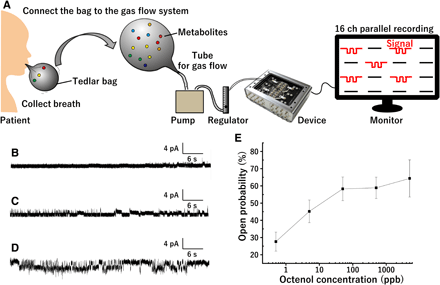
東京大:蚊の嗅覚でにおい検出成功:肝臓がんの予兆感知(動画):
Tokyo Univ: Odor detect by mosquito olfaction: Signs of liver cancer:
东京大学:通过蚊子气味成功检测气味:检测肝癌体征
東京大:
神奈川県立産業技術総合研究所:
東京大と神奈川県立産業技術総合研究所の研究チームが発表した。
嗅覚受容体組み込みセンサー:
「蚊の触覚にあり、人のにおいを感知する嗅覚受容体」を組み込んで作ったセンサー。
研究チームが、「人の呼気から、がんの進行度を示す微量のにおいを検出すること」に成功した。
米科学誌に13日掲載された。
「腫瘍マーカー」を呼気で検出:
将来的には、がんの進行度を示す数値「腫瘍マーカー」を呼気から検出することも可能になる。
におい反応センサー開発:
研究チームは、人の汗のにおいを感じる蚊の嗅覚受容体を用いて、においに反応して動くロボットを開発した。
電気信号が流れる回路を作り、センサーにして反応させる仕組みだ。
研究チームは、「人工細胞膜に、受容体を組み込んだセンサー」を開発した。
におい分子を感知させる際、においと受容体が、高い確率で結合するようにした。
肝臓がんのにおいを検出:
研究チームは、このセンサーで肝臓がんの進行度などを示す腫瘍マーカーと考えられている「オクテノール」を含むガスを測定。
その結果、0・5ppb(ppbは10億あたりどれぐらいあるかを示す単位)の微量なにおいを検出することに成功した。
イザ!
https://www.iza.ne.jp/smp/kiji/life/news/210114/lif21011409100003-s1.html
東京大学:蚊の匂い受容体で呼気診断!?
~蚊の嗅覚受容体を用いたセンサ:0.5ppbレベルの匂いの検出に成功~
2021.01.14
発表のポイント:
◆人工の細胞膜上に蚊の嗅覚受容体(注1)を組み込んだ匂いセンサによって、呼気に混合した0.5 ppbという微量のガンマーカーを嗅ぎ分けることに成功しました。
◆水溶液に対し、せん断方向に匂い分子を含む気体を流すことで、水に難溶性である匂い分子を気中から水溶液中に効率良く分配できることを明らかにしました。
◆感度や分子識別能力で従来技術をしのぐ匂いセンサを実現し、呼気診断や環境計測、危険物検知などへの応用を目指します。
– 東京大学生産技術研究所
https://www.iis.u-tokyo.ac.jp/ja/news/3457/
Highly sensitive VOC detectors using insect olfactory receptors reconstituted into lipid bilayers
Science Advances 13 Jan 2021:
Vol. 7, no. 3, eabd2013
DOI: 10.1126/sciadv.abd2013Abstract
This paper reports a volatile organic compound (VOC) sensor based on olfactory receptors
that were reconstituted into a lipid bilayer and used in a specifically designed gas flow system for rapid parts per billion (ppb)–level detection.
This VOC sensor
achieves both rapid detection and high detection probability because of its gas flow system and array design.
Specifically, the gas flow system
includes microchannels and hydrophobic microslits, which facilitate both the introduction of gas into the droplet and droplet mixing.
We installed this system
into a parallel lipid bilayer device and subsequently demonstrated parts per billion–level (0.5 ppb) detection of 1-octen-3-ol in human breath.
Therefore, this system extends the various applications of biological odorant sensing, including breath diagnosis systems and environmental monitoring.
Science Advances